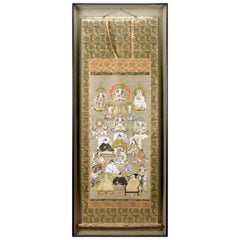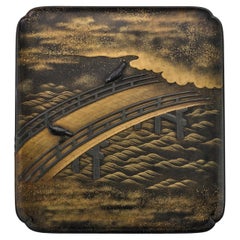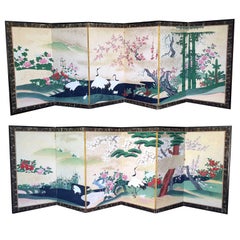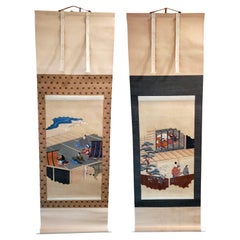TISHU Furniture
33
to
33
33
33
33
146
310
591
99
154
192
177
21
4
17
12
29
43
49
69
31
25
21
9
7
6
5
30
27
14
8
4
Period: Early 19th Century
Fine Antique Korean Ceramic Water Dropper Joseon Dynasty
Located in Atlanta, GA
A fine porcelain water dropper from Korea circa 19th century of the late Joseon Dynasty. Water dropper is one of the essential scholar objects in the Confucius Joseon society where ink calligraphy was considered an important cultivation of an educated man. The water dropper is a small contained made to drop the water onto the ink stone to grind the ink stick for writing. These miniature objects were made in various forms as little wonders as a desktop accessory for the Scholar's study.
The water dropper on offer was made of porcelain and covered in a grey celadon glaze. It was molded in the form of a beach with finely sculpted stalk and leaves. A slight red was dotted on the two openings. The surface also has a carved grape or pomegranate motifs under the glaze. There is some slightly running of the celadon glaze on top. The base has residues of kiln grits.
Although the peach form was perhaps one of the most common ones among the Korean water droppers...
Category
Antique Early 19th Century Korean Other Scholar's Objects
Materials
Ceramic
Japanese Silk Suijaku Scroll Nyorai-Kojin with Mixed Buddhism and Shinto Deities
Located in Atlanta, GA
A Japanese silk Suijaku hanging scroll beautifully presented in a custom wood shadow box frame from Edo period (circa 18-19th century). The scroll, surmounted on golden brocade was painted in fine details with gouache, ink and gold powder highlight, served as a Suijaku mandala for the worshippers. Honji Suijaku is a complicated religious concept uniquely developed in Japan. It mixed and hybrid the Buddism deities with native shinto spirits (known as Kami), which were seen as local manifestations (the suijaku, literally means a "trace") of Buddhist deities (the honji literally the original ground). The original idea may lie with the synergetic strategy to spread Buddism by making it more relatable to the local population who had already worshiped Shinto gods. The paradigm, adopted in the 10th century from an orignal Chinese concept, remained a defining feature of Japanese religious life up to the end of the Edo period (1868). Instead of being confined to deities, its application was often extended to historical figures as shown on this scroll.
This long hanging scroll depicts an arrangement of 21 figures including Buddhism and Shinto deities as well as two historical figures on the bottom. Each figure was name-tagged in Kanji for easy identification by the worshippers. It was used in the temple or shrine so that when the worshipper prayed in front the mandala, they prayed simultaneously to all the deities.
On the very top, sits Nyorai-Kojin, a hybrid deity of Nyorai Buddha and Kojin, the kaki for fire, stove and kitchen. From the top to bottom and left to right, here is the list of the deities: Kanon with Thousand Hands, Kanon with Willow Branch, Monju Bosatsu...
Category
Antique Early 19th Century Japanese Edo Paintings and Screens
Materials
Silk, Wood
Exquisite Japanese Lacquer Maki-e Suzuribako by Koma Kyūhaku Edo Period
Located in Atlanta, GA
One of the finest Japanese Maki-e Suzuribakos (ink box) we have on offer, the roiro color box showcases an ambient nocturnal scene in which two shakudo inlaid crows perched on the handrails of a bridge (possible the Uji Bridge...
Category
Antique Early 19th Century Japanese Japonisme Lacquer
Materials
Stone, Metal
Pair of Rare Antique Japanese Folding Screens with Provenance
Located in Atlanta, GA
An amazing pair of matching antique Japanese folding screen predating 1812-1813, most likely from Kano School. Six panels each depict C...
Category
Antique 1810s Japanese Japonisme Paintings and Screens
Materials
Brass
Early 19th Century Tibetan Painted Bible Table
Located in Atlanta, GA
Furniture from Tibet has always been quite rare. Except for the wealthy, Tibetans used very little furniture in their homes, and the population of Tibet has always been so small that not much was ever made. Most of it is found in the monasteries.
This beautiful Tibetan bible...
Category
Antique Early 19th Century Tibetan Furniture
Materials
Pine, Paint
Two Antique Japanese Hanging Scroll Paintings
Located in Atlanta, GA
Two Japanese scroll painting depicts scenes from the Tale of Genji (Genji-E), from Edo period. These painting were purchased from Odewara Shoten in the...
Category
Antique Early 19th Century Japanese Japonisme Paintings and Screens
Materials
Brocade, Paper
Framed Antique Embroidery Chinese Textile Qing Dynasty Provenance
Located in Atlanta, GA
A piece of beautiful antique textile fragments from China, circa 19th century Qing dynasty, artistically displayed in a giltwood frame with co...
Category
Antique Early 19th Century Chinese Chinese Export Textiles
Materials
Silk, Giltwood
Two Korean White Ceramic Jars Joseon Dynasty
Located in Atlanta, GA
Two ensuite Korean porcelain jars circa early 19th century Joseon Dynasty, attributed to Punwon-ri ware and measures 5.5" diameter x 4" height and...
Category
Antique Early 19th Century Korean Archaistic Ceramics
Materials
Ceramic
Japanese Seto Mingei Ceramic Plate Ishizara Edo Peorid
Located in Atlanta, GA
A glazed stoneware Ishizara (food serving platter) from Seto kilns. The platter features an unusual lobed edge and a slight irregular form from hand made....
Category
Antique Early 19th Century Japonisme Centerpieces
Materials
Ceramic
Japanese Antique Lacquer Maki-E Miniature Hasami-Bako with Copper Mounts
Located in Atlanta, GA
A Japanese lacquered box with lid in the shape of a miniature Hasami-Bako (traveling chest) circa late 18 to early 19th century of the Edo period. The black box is decorated with fin...
Category
Antique Early 19th Century Japanese Japonisme Lacquer
Materials
Copper
Pair of Large Japanese Carved Wood Temple Candleholders Edo Period
Located in Atlanta, GA
A tall pair of Japanese carved wood candle holders circa early 19th century (late Edo Period). The pair is carved in the typical form with a block base in the shape of stylized chrysanthemums and long fluted stem with changes in diameter that supports a grooved holder fitted with metal pricket. These types of oversized candle holders were traditionally used in Buddhist temples or Samurai's resident where they were placed on the altar table for worshiping. What is extraordinary of these candle stickers is that they feature a wonderfully conserved surface with lacquered gold leaf. The sparkling gold on the well weathered surface is visually striking. The professional conservation was performed in 2007 and as a result, the pieces display a wonderful aged Wabi-Sabi patina.
The piece retains an original invoice from Far Eastern Antiques...
Category
Antique Early 19th Century Japanese Japonisme Lacquer
Materials
Gold Leaf
19th Century Chinese Carved Wooden Altar God
Located in Atlanta, GA
This Ching Dynasty carved polychrome seated Taoist altar god was once used on the family altar to honor their ancestors. Ancestor worship plays a major role in Chinese religion. This...
Category
Antique Early 19th Century Sculptures and Carvings
Materials
Paint, Wood
Rare Large 19th Century Carved Chinese Wooden Stool
Located in Atlanta, GA
This unusual carved Chinese wooden stool is from the Qing dynasty (circa 1820). The stool is finely carved from the center of a northern elm (Yumu...
Category
Antique Early 19th Century Chinese Furniture
Materials
Wood, Elm
19th Century Chinese Cypress Root Brush Pot
Located in Atlanta, GA
Beautiful organic shaped Cypress root brush pot. This cypress root was carved out to hold the scholar’s calligraphy brushes. The aged natural patina enhances the beautiful wood grain...
Category
Antique Early 19th Century Chinese Scholar's Objects
Materials
Cypress
19th Century Chinese Cypress Root Brush Pot
Located in Atlanta, GA
Beautiful organic shaped Cypress root brush pot. This cypress root was carved out to hold the scholar’s calligraphy brushes. The aged natural patina enhan...
Category
Antique Early 19th Century Chinese Scholar's Objects
Materials
Cypress
19th Century Chinese Cypress Root Brush Pot
Located in Atlanta, GA
Beautiful organic shaped Cypress root brush pot. This cypress root was carved out to hold the scholar’s calligraphy brushes. The aged natural patina enhan...
Category
Antique Early 19th Century Scholar's Objects
Materials
Cypress
19th Century Chinese Cypress Root Brush Pot
Located in Atlanta, GA
Beautiful organic shaped Cypress root brush pot. This cypress root was carved out to hold the scholar’s calligraphy brushes. The aged natural patina enhan...
Category
Antique Early 19th Century Chinese Scholar's Objects
Materials
Cypress
19th Century Northern Thai Temple Roof Finials, Carved Chofa
Located in Atlanta, GA
This temple roof final is from the Isan region of Northern Thailand. Hand carved from teakwood into the shape of a chofa, it was used as an architectural...
Category
Antique Early 19th Century Thai Sculptures and Carvings
Materials
Teak
Early 20th Century Chinese Opera Marionette Puppet
Located in Atlanta, GA
This Chinese opera marionette puppet is dress in an elegant embroidered silk dragon robe. The puppet head is of painted ceramic. The ornate headdress...
Category
Antique Early 19th Century Chinese Toys
Materials
Ceramic, Fabric
Japanese Monastery Robe Patchwork Kesa with inscription Edo Period
Located in Atlanta, GA
A Japanese Kesa (Monk's Vestment) made from fourteen columns of patchworks of blue brocades with sumptuous woven pattern. The elaborate motifs feature re...
Category
Antique Early 19th Century Japanese Japonisme Textiles
Materials
Brocade, Silk
19th Century Chinese Red Lacquer Cabinet with Gilded Butterflies
Located in Atlanta, GA
Beautifully painted Chinese red lacquered cabinet with gilded butterflies. Hand crafted and hand painted from the Shanxi province of north China durin...
Category
Antique Early 19th Century Chinese Furniture
Materials
Elm, Lacquer
19th Century Chinese Walnut Altar 'Hetao Mu' Table
Located in Atlanta, GA
This beautifully carved 19th century altar table is traditionally constructed with mortise and tenon joinery from walnut wood (Hetao Mu). The ...
Category
Antique Early 19th Century Chinese Furniture
Materials
Walnut, Lacquer
Petite 19th Century Chinese Wine Table
Located in Atlanta, GA
This unusual 19th century petite wine table is carved from Yumu (Chinese Northern Elm) and is from the Shanxi province of northern China. The table is made with traditional mortise and tenon construction. The legs are gracefully carved with a stylized curved organic line and rounded...
Category
Antique Early 19th Century Chinese Furniture
Materials
Elm
Framed Chinese Embroidered Silk Collar Qing Dynasty
Located in Atlanta, GA
An embroidered silk collar from China dated to late Qing Dynasty circa 19th century. Known as Yunjian (Cloud Shoulder or Cloud Collar), this multi-lobed t...
Category
Antique Early 19th Century Chinese Qing Textiles
Materials
Silk
Framed Chinese Embroidered and Appliqued Silk Collar Qing Dynasty
Located in Atlanta, GA
A silk collar from China dated to late Qing Dynasty circa 19th century. Known as Yunjian (Cloud Shoulder or Cloud Collar), this multi-lobed textile piece was a detachable collar worn around the shoulders as part of the traditional Chinese garment accessory. With its origin dated back to the Han Dynasty and being used until the end of Qing Dynasty, the form evolves with time, but much of the ornamentation and fundamental symbolism remains the same.
This striking example features a two-tiered design with eight lobes on each circle, all of which are variations of the shape of auspicious "ruyi", which represents the head of Lingzhi mushroom, a symbol of longevity. The inner lobes were made with appliqued patchwork of colorful silk. The outer lobes feature elaborate embroidery of assortment of colorful flowers, scrolling ribbons and butterfly, using mostly long and short satin stitches. The borders and outlines of the designs were lineated with metallic threads buddled in chain stitches. Small black pearls were used to link the piece together and most of them still remain.
In Qing Dynasty, the silk collar with high quality was worn by noble or aristocratic women. The red color and the lotus boy symbol indicate that it was most likely part of the fashion accouterment worn during wedding ceremony.
The collar is beautifully float mounted within a double conforming mat in a giltwood frame and wood backing. A stunningly presented period piece with story to tell.
Reference: For a collection of Chinese embroidered collars...
Category
Antique Early 19th Century Chinese Qing Textiles
Materials
Silk
Framed Chinese Embroidered Silk Collar Qing Dynasty
Located in Atlanta, GA
A silk collar from China dated to late Qing Dynasty circa 19th century. Known as Yunjian (Cloud Shoulder or Cloud Collar), this multi-lobed textile piece was a detachable collar worn around the shoulders as part of the traditional Chinese garment accessory. With its origin dated back to the Han Dynasty and being used until the end of Qing Dynasty, the form evolves with time, but much of the ornamentation and fundamental symbolism remains the same.
This striking example features a two-tiered design with seven lobes on each circle, all of which are variations of the shape of auspicious "ruyi", which represents the head of Lingzhi mushroom, a symbol of longevity. The inner lobes feature elaborate embroidery floral design with long and short satin stitches. Notably, one panel has a double gourd design, the symbol of fortune. The outer lobes show a simpler but bolder vision with the outlines of the designs lineated with metallic threads buddled in chain stitches. Small jade beads were used to link the piece together and most of them still remain. The piece as a whole has a very pleasant lilac purple color, delicate with the jade beads.
In Qing Dynasty, the silk collar with high quality was worn by noble or aristocratic women. The red color and the lotus boy symbol indicate that it was most likely part of the fashion accouterment worn during wedding ceremony.
The collar is beautifully float mounted within a double conforming mat in a giltwood frame and wood backing. A stunningly presented period piece with story to tell.
Reference: For a collection of Chinese embroidered collars...
Category
Antique Early 19th Century Chinese Qing Textiles
Materials
Silk
Large Early 19th Century Gilded Carved Wooden Vietnamese Buddha
Located in Atlanta, GA
A highly decorative early 19th century Vietnamese carved wooden and polychrome painted Buddha with traces of original gilding, creating a beautiful p...
Category
Antique Early 19th Century Vietnamese Sculptures and Carvings
Materials
Wood
Early Japanese Gohonzon Buddhist Calligraphy Mandala Scroll Edo Period
Located in Atlanta, GA
A Japanese sumi ink calligraphy Buddhist mandala mounted as a paper hanging scroll known as Kakejiku or sometimes Moji mandala. Termed as gohonzon in Japanese, it is a venerated object within Nichiren Buddhism (Hokkeshu; lotus sect). The originally concept was developed by the 13th century Buddhist priest Nichiren to guide the energy of the devotional chanting to...
Category
Antique 1810s Japanese Edo Paintings and Screens
Materials
Paper
19th Century Chinese Carved Wooden Altar God
Located in Atlanta, GA
This Chinese carved seated altar god was once used on the family altar to honor their ancestors. Ancestor worship plays a major role in Chinese religion. This beautifully carved figure is rich with character from a century of use with wonder signs of wear. The darken patina is created through years of burning of incense with the original gold gilt painting...
Category
Antique Early 19th Century Chinese Sculptures and Carvings
Materials
Wood, Paint
Framed Chinese Embroidered Silk Collar Qing Dynasty
Located in Atlanta, GA
A silk collar from China dated to late Qing Dynasty circa 19th century. Known as Yunjian (Cloud Shoulder or Cloud Collar), this two-tiered, five-lobed textile piece was a detachable collar worn around the shoulders as part of the traditional Chinese garment...
Category
Antique Early 19th Century Chinese Qing Textiles
Materials
Silk
Large Terracotta Head of Luohan on Wood Stand from Vietnam
Located in Atlanta, GA
A large and heavy fired clay (terracotta) head of an Arhat (also known as Luohan in Chinese). The followers of Buddha who achieved the enlightenment, statues of Arhats are always fou...
Category
Antique Early 19th Century Vietnamese Other Sculptures and Carvings
Materials
Terracotta, Wood
Large Striking Korean Ton-Kwe Chest Persimmon Wood Joseon Dynasty
Located in Atlanta, GA
A large Korean top-lid chest on block feet circa late 19th century Joseon Dynasty. Known as coin chest (Ton-Kwe in Korean), this type of chest was originall...
Category
Antique Early 19th Century Korean Other Furniture
Materials
Iron
Antique Korean Ton-Kwe Chest Joseon Dynasty
Located in Atlanta, GA
A large Korean top-lid chest on block feet circa 19th century of Joseon Dynasty. Known as coin chest (Ton-Kwe in Korean), this type of chest was originally used for storing money. Th...
Category
Antique Early 19th Century Korean Other Furniture
Materials
Iron





